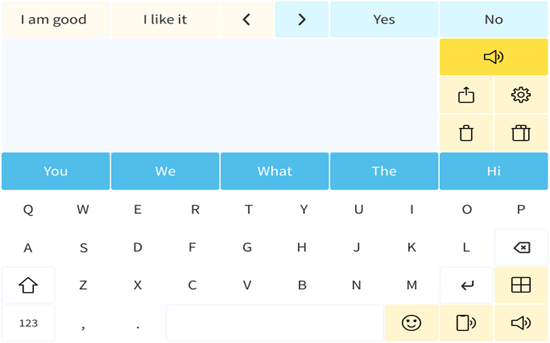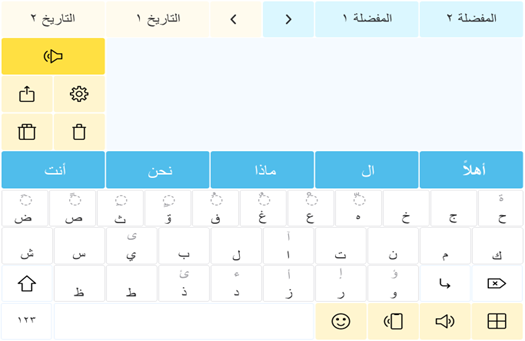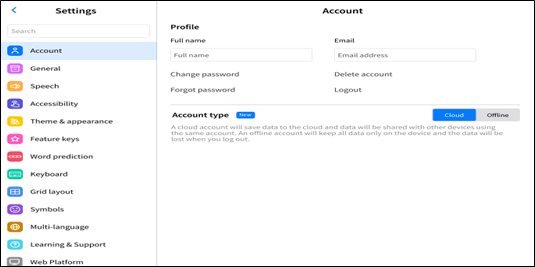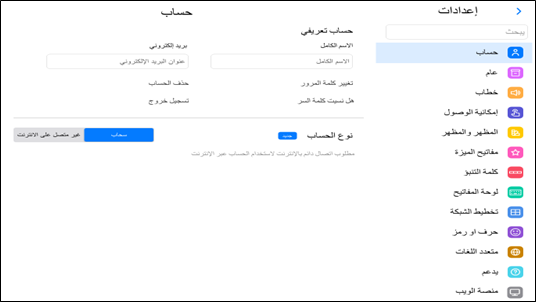Localization of a Text-based App for Arabic Assistive Technology Users
Research article  Open access |
Available online on: 29 December, 2023 |
Last update: 10 March, 2024
Open access |
Available online on: 29 December, 2023 |
Last update: 10 March, 2024
Abstract
Ensuring the successful adaptation of Predictable, a text-based Alternative and Augmentative Communication (AAC) app for users in the Gulf region, required not only text translation and integration of an Arabic keyboard. Key considerations encompass design and user experience, particularly regarding button selection and arrangement to accommodate right-to-left orientation and address cultural and linguistic nuances. The localisation of Predictable Arabic for AAC users in the Gulf region is further enhanced by leveraging an existing symbol set while incorporating new symbols optimised for the app.
Keywords
Alternative and Augmentative Communication, Predictable Arabic, Localisation.
1. Introduction
Predictable (or Therapy Box) is a text-to-speech app used by people with progressive and developmental conditions who use it when their speech is limited or absent. It is an alternative and augmentative communication (AAC) aid used by people with various conditions, including motor neurone disease, cerebral palsy, autism, aphasia, and Parkinson’s Disease.
The app uses word prediction to save time in composing messages, and it provides people with limited motor control accessibility options that enable them to use whichever body part or movement they can – from a switch controlled by the hand, a head or foot switch, head tracking, face gestures or eye tracking. Predictable accommodates for tremors and hand movement difficulties. People can create phrases for quick access so that they are ready for classes, appointments, or meetings. They can also use ‘floorholding’, which allows automatic messages to play while they are typing so others do not interrupt. It is highly customisable and flexible. Core technologies involved are synthetic speech engines, word prediction modules, and various accessibility features. Each setting can be selected and modified with a user’s needs in mind to enable efficient communication and, where possible, reduce the effort and fatigue that communicating using AAC may invoke. It is currently used by people in 35 countries and nine core languages other than English. Developing an Arabic version required the app’s localisation, which involved work regarding user experience, linguistic integrity, and cultural considerations.
2. Design Process
The seventh major release for Predictable is currently in development. The design and development team utilise a design process informed by widespread user involvement since the first release in 2011. The core components of the app’s design have been refined following direct consultations, usability testing sessions, and feedback from existing and new app users globally. Therefore, much of this design work has fed into the design and development of Predictable Arabic. Following a requirement-gathering phase and research related to Arabic design methodologies, the team undertook wireframing and visual prototyping of Predictable Arabic’s user experience, which was shared with stakeholders.
3. User Experience Design Considerations
Given that the Predictable app had previously only been used for Left-To-Right (LTR) based scripts, the first design consideration was evaluating and redesigning our key interface screens to be optimised for Arabic, a Right-To-Left (RTL) script. Key elements of the main keyboard and phrase screens were moved from the right to the left, including our ‘feature key’ section, where the ‘speak’ button and other functions such as delete, and undo are located. The script in the message window shifted to RTL, and several of the essential accessibility functions that are text-related, such as highlighting and the cursor, were also adjusted.
Interface icons were reviewed, and where relevant, they were flipped, such as in Figure 1 and Figure 2. Some interface icons included letters or words to help communicate a script-related concept, and others displayed a directional aspect. For example, the icon representing a speaker showed sound waves emanating from the speaker. In the LTR context of Predictable English, for example, the sound waves come from the left, so in the RTL context, for Predictable Arabic, the icon needed to flip to show the waves coming from the right (Figure 2). However, many icons remained unchanged, such as the eye gaze icon and export icons.

Figure 1. Left-to-right and right-to-left symbols for handwriting function
Figure 2. Left-to-right speak symbol and right-to-left speak symbol
The keyboard illustrated in Figure 3, as is the word prediction strip, is integral to Predictable. For Predictable Arabic, the Arabic Keyboard aligned with the iOS keyboard for Arabic and similarly used the shift key to switch between cases (See Figure 4). Slight placement changes have been made to fit the Predictable layout, as it needs to fit with keyguards and work well with switch scanning, head tracking and eye tracking. Arabic numerals were also used for the numeric keyboard screen.

Figure 3. Keyboard screen for Predictable English

Figure 4. Keyboard screen for Predictable Arabic
In addition to the app’s main keyboard and phrase pages, the settings screen was also localised for right-to-left usage. The placement of toggle switches for choice-making within the settings options was also adjusted where required, as were the location of tick marks, back arrows, bullet point lists, hint text and headers, as shown in Figure 5 and Figure 6.

Figure 5. Settings screen for Predictable English

Figure 6. Settings screen for Predictable Arabic
4. Localising Text
Localisation requires more than simple translation. The architecture for Predictable leverages an approach to localising text strings for use within the app, such as error messages and other content. This required a file where all resources are stored for a particular language localisation, in this case, Arabic. The routines that lookup key values in a property list file consider the user’s language preferences and return the localised version of the key from the appropriate file when one exists. Using a property list in the base language, English, a local translator can provide the translations systematically rather than going through and translating each button or text string within the app.
5. Designing Symbols
Symbols can generally be identified or understood, regardless of the person’s language or literacy skills, and many have universal applications. Huer (2000) suggested that people from some cultural backgrounds may not perceive symbols similarly. Further research has suggested challenges in the Arab region using symbol sets designed outside the region (Elsheikh and Zeinon, 2019). This leads to the potential for greater uptake of AAC in general if a localised symbol set is used (Elsheikh and Zeinon, 2019). The Tawasol symbols designed for this particular purpose have been used in the region since, and preliminary evaluation of those symbols demonstrated that the symbols encouraged participation (Draffan et al., 2015). Therefore, the Predictable Arabic app will include the Tawasol symbols (MADA Assistive Technology Center and Partners), and a full complement of symbols were localised from Predictable English for use in Predictable Arabic. Input regarding cultural appropriateness and usability was taken into consideration. Following an audit of the symbols available in Predictable English, suitable alternatives were designed and implemented. For instance, Figure 7 was intended to represent the words for hospital and clinic, which were altered to include a red crescent replacing the red cross. As a result, new symbols were added to the overall Predictable database.

Figure 7. Proposed Predictable symbol for hospital localised for the Arabic version of the app.
6. Opportunities for Future Development and Research
Future work may seek to optimise the design of AAC apps for bilingual language users, including for rapid switching between the user’s language choices and code-switching behaviours. This would complement further development and research addressing global symbol usage and personalised dynamic AAC systems that are customised for each user’s unique physical, linguistic, sensory and cognitive abilities and adapt to each environment, to fatigue issues and from feedback for each user.
7. Conclusion
Effective localisation of a text-to-speech app for Arabic users requires translating text and implementing an Arabic keyboard. Design and user experience considerations related to the choice and layout of buttons to reflect a right-to-left design and cultural and linguistic factors are paramount. Building on using an existing symbol set and adding new and redesigned symbols assists in localising Predictable Arabic for AAC users in the Gulf region.
References
Draffan, E.A., Wald, M. and Halabi, N. et al. (2015). Generating acceptable Arabic Core Vocabularies and Symbols for AAC users. 6th Workshop on Speech and Language Processing for Assistive Technologies, Dresden, Germany. pp. 91-96. (doi:10.18653/v1/W15-5116).
Elsheikh, A., and Zeinon N, 2019. Mada Tawasol Symbols & Mobile App, 7th International Conference on ICT & Accessibility (ICTA), Hammamet, Tunisia, 2019, pp. 1–5, doi: 10.1109/ICTA49490.2019.9144883.
Huer, M., (2000). Examining perceptions of graphic symbols across cultures: Preliminary study of the impact of culture/ethnicity, Augmentative and Alternative Communication, 16:3, 180–185, DOI: 10.1080/07434610012331279034
Predictable (Therapy Box), https://apps.apple.com/gb/app/predictable/id404445007.
Tawasol symbols, https://tawasol.mada.org.qa/?lang=en (Tawasol symbols are available under a CC BY-SA 4.0 licence)
